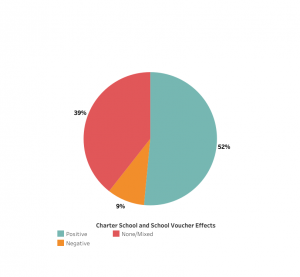by Thomas Snyder, UCA Professor of Economics and ACRE-Affiliated Scholar
The topic of school choice is back at the forefront in Arkansas with our new Governor Sarah Huckabee Sanders. One of the most common arguments you’ll hear against school choice is “What about those students left behind in traditional public schools?” If public money and resources goes towards a charter school, or towards a voucher to a private school, one can argue that those dollars are diverted away from improving traditional public schools. This diversion could mean that students left behind in traditional public schools will be hurt.
On the other hand, someone can reasonably argue the opposite effect is true: an alternative choice of schooling can put pressure on the traditional public school to improve its teaching effectiveness, etc., to attract students and resources. For example, a grocery store will have to offer quality food for an acceptable price to attract customers when a competing grocery store opens its doors nearby. And the grocery store analogy has another connection: one of the largest assistance programs in the U.S. for low-income families is SNAP benefits (“food stamps”) which allow families to choose where they spend money on groceries. We might call it “food choice.”
If logical arguments can be made for both the positive and the negative effect of school choice on traditional public school students, there is one thing to do: look at the data!
Does the data say that school choice harms students left behind in a traditional public school? Most of the research says “No.” West Virginia University economists investigated a similar question in their state and found that more homeschooling and private school enrollment improved public school districts’ test scores (Cebula, Hall, Tackett 2016). An earlier study (Holmes, Desimone, & Rupp, 2006) discovered students in North Carolina’s traditional public schools achieved higher test scores when charter schools competed for their enrollment. And this increase in test scores in traditional public schools happened even though the typical student going to the competing charter school was an above-average performer!
Those weren’t the only studies on the subject. A brief by Mathematica (Max, et al. 2019) systematically summarized this literature. When looking at the effect of charter schools on student performance in traditional public schools, they discovered that 9 studies showed a positive effect, 3 studies showed a negative effect, and 12 studies found either no effect or a mixed effect. When looking at the effect of private school vouchers on student performance in traditional public schools, they discovered 8 studies that found a positive effect, 1 study that found no effect, and zero studies that found a negative effect. If you were to combine these findings in a pie chart, it would look like pie chart below:
Studies on the Effect of School Choice on Traditional Public Schools
In a similar review by edchoice.org in 2022, they found that of the 28 studies that examined private school choice programs, 25 found positive effects on the scores of students who remained in public schools. There was also a review of the literature on vouchers published in the Journal of Economic Literature which found that “Evidence on both small-scale and large-scale programs suggests that competition induced by vouchers leads public schools to improve” (Epple et al. 2017). That review of the research also suggests that not every voucher program has been successful, but that researchers are learning what works and what doesn’t. Arkansas can learn from what other states have tried.
With these findings, we can start to feel more comfortable about the effects of school choice on traditional public students. But what would make us even more comfortable? Perhaps a study that was focused on Arkansas, not on other states. We have two of these studies. Researchers affiliated with the Arkansas Center for Research in Economics (ACRE) have done two studies regarding the impact of school choice on students in traditional public schools, both published in academic journals.
The first study by Kalulu, Snyder and Ouattara (2017) found that elementary school students in Arkansas’ traditional public schools performed better in math, reading, and language test scores in school districts that had a larger percentage of students enrolling in charter schools, controlling for relevant factors.
Instead of just looking at a student’s academic performance, our second study examined student behavior. A student with more schooling options may find a place more comfortable than their designated traditional public school (which is a reason to seek an alternative school in the first place). The study by Snyder, Newell, and Kalulu (2019) found a positive relationship between charter school enrollment and student behavior in traditional public schools. Their estimates indicated that a one percentage point increase in charter school enrollment (as a percentage of total enrollment) in a school district was associated with 4.9 fewer disciplinary infractions per 100 students.
When presented with this evidence, policymakers may feel less worried about the harm school choice can have on students in traditional public schools. In fact, the evidence suggests that restricting school choice may be more harmful. Even in the minority of studies that found a negative impact on traditional public schools from increased competition with public charters, Arkansas can learn from mistakes that other states have made.
Given that competition from public charters and private schools often improves performance in traditional public schools, policymakers should be able to set this concern aside and focus on the other potential benefits and costs of increasing school choice in Arkansas.

